Bulletin – December 2015 Global Economy Assessing China's Merchandise Trade Data Using Mirror Statistics
- Download the article 304KB
Abstract
Given their timeliness, Chinese trade data have the potential to provide a useful early read on conditions in the Australian and global traded sectors. However, the reliability of China's merchandise trade data has come under scrutiny in recent years, particularly following reports of over-invoicing of exports to Hong Kong. This article considers the accuracy of China's trade data by comparing the merchandise trade statistics with the reciprocal trade statistics or ‘mirror’ statistics published by its major trading partners (MTPs). In broad terms, growth in trade suggested by the mirror statistics aligns relatively closely with published Chinese data, though the Chinese figures are found to imply more volatile and somewhat higher growth in exports over the past three years than the corresponding trading partner data. While this largely reflects differences with mirror statistics for Hong Kong, it is also due to discrepancies with data from other economies, primarily in the Asian region.
Background
There has been considerable debate about the accuracy of China's headline economic statistics for many years.[1] International trade is one area in which the Chinese data can be compared with statistics published by other economies to assess the validity of concerns about data quality. Accordingly, China's merchandise trade statistics have come under scrutiny in recent years, largely because China's reported exports to Hong Kong grew at a much faster pace than the corresponding statistics Hong Kong published on imports from China. This article seeks to assess the broader accuracy of China's merchandise trade statistics by comparing the data with the corresponding mirror statistics reported by a range of their MTPs.
The accuracy of China's merchandise trade data is of particular interest because of their potential to provide a timely read on global demand conditions, given the importance of China to regional and world trade. China's merchandise trade data are typically published less than two weeks after the end of the month and are available before most of China's MTPs publish their corresponding statistics. In the case of Australia, Chinese trade data are available about three weeks before Australian trade data.
Merchandise trade data do not feed directly into the estimation of headline GDP in China by the statistical authorities, since the national accounts are mainly compiled on a production, rather than an expenditure, basis. As such, this work cannot be used to draw broader implications for the accuracy of China's GDP data.
Sources of Discrepancies in Trade Data
China's merchandise trade statistics are reported by the customs authority on a monthly basis and include a detailed breakdown of the types of goods and the source or destination country of China's imports and exports. China's MTPs similarly compile international trade statistics using administrative data collected by their respective customs authorities (IMF 2009, p 116). While China and its trading partners follow many of the recommendations in the United Nations (UN) guidelines for compiling trade statistics, there are a number of reasons to expect that the export data of one country will not align precisely with the corresponding import data of a trading partner (United Nations 2011). Some discrepancies reflect methodological differences, for which adjustments can be made, while others may reflect accidental or intentional misreporting of trade flows by firms.
Re-exports and transhipment
A considerable share of China's trade is exported to Hong Kong and then re-exported on to another destination without being substantially transformed in the process. Despite declining in recent years, this share was still around 12 per cent of total trade in 2014.[2] Re-exports can cause discrepancies between the data of China and its trading partners for several reasons. First, in general, the importer is more likely to know the origin of the goods than the exporter is to know the final destination. For example, an export from China to Australia via Hong Kong may be recorded by the Chinese authorities as an export to Hong Kong, but as an import from China by the Australian authorities. Second, even if the origin and destination are correctly identified by each country, the reported value of the transaction may be different if a significant mark-up has been applied by the re-exporting economy.
For Hong Kong, this issue can be addressed by using re-export statistics by destination and origin. However, these disaggregated data are not available for other economies, such as Singapore, which also re-export goods to and from China. Some discrepancies may also remain due to ‘transhipment’, whereby goods are shipped via a third country but without clearing customs (Ferrantino and Wang 2008).[3] Transhipments are not included in the re-export data, although they could cause similar problems in identifying the final destination of exports.
Valuation and timing
As recommended in the UN guidelines, imports are normally reported on a cost of insurance and freight (CIF) basis, while exports are reported on a free-on-board (FOB) basis (United Nations 2011). Therefore, import values are expected to be greater than the corresponding export values by an amount equal to shipping and insurance costs. Conversion of trade flows to a single currency by statistical agencies can also lead to differences when the exchange rates used relate to different time periods. In addition, shipping times can cause a difference between when exports and imports are recorded, because exports (imports) are recorded when goods leave (enter) the economic territory of the compiling country.[4]
Misreporting
The trading entity misreporting the origin, destination or the value of goods to the relevant statistical agency, either intentionally or accidentally, can cause discrepancies between the statistics reported by each trading partner. Incentives for misreporting include tax and tariff minimisation, circumvention of quotas or embargos, and evasion of capital controls.
Comparing Trade Statistics
Data and adjustments
For this analysis, trade statistics were collected for more than 40 of China's trading partners, which together accounted for more than 70 per cent of the value of Chinese trade in 2014 (Table 1). Trade with economies in the Middle East, Africa and Latin America account for most of the remaining trade, and are not included in this analysis as complete and timely data are not generally available.[5]
To account for the known technical differences in import and export data described above, the following adjustments were made:
- Trade flows not reported in US dollars were converted using the month-average spot rate of the relevant currency pair to enable all comparisons to be made in US dollars.
- For imports reported on a CIF basis, the FOB value was estimated by assuming that the cost of insurance and freight accounted for 5 per cent of the value.[6]
- The quarterly sums of the monthly figures were examined to smooth volatile month-on-month movements and to help account for the timing difference in recording exports and imports. Using quarterly sums also minimises distortions due to Chinese New Year-related calendar effects in January and February.
| Exports | Imports | Total trade | |
|---|---|---|---|
| East Asia(a) | 14.5 | 26.2 | 19.8 |
| European Union (EU) | 15.8 | 12.4 | 14.3 |
| United States | 16.9 | 8.1 | 12.9 |
| Hong Kong | 15.5 | 0.7 | 8.7 |
| Japan | 6.4 | 8.3 | 7.3 |
| Australia | 1.7 | 5.0 | 3.2 |
| Russia | 2.3 | 2.1 | 2.2 |
| Brazil | 1.5 | 2.6 | 2.0 |
| India | 2.3 | 0.8 | 1.6 |
| Canada | 1.3 | 1.3 | 1.3 |
| Total | 78.1 | 67.6 | 73.3 |
|
(a) Indonesia, Malaysia, Philippines, Singapore, South Korea, Taiwan and Thailand Sources: CEIC Data; RBA |
|||
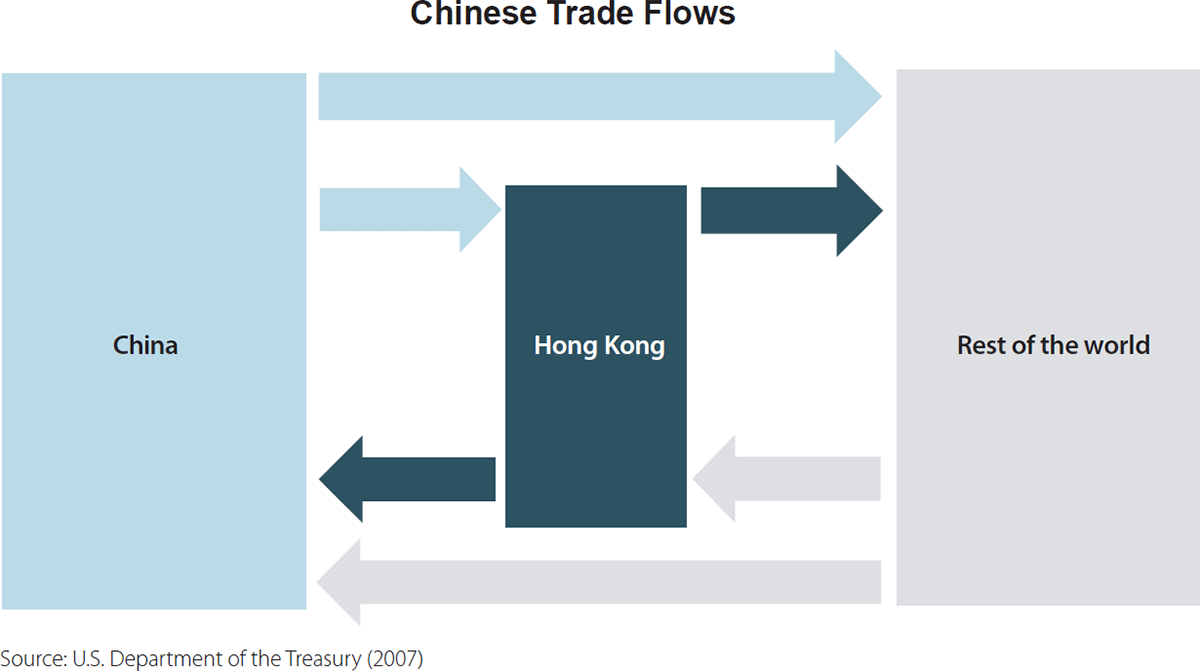
This figure shows the role of Hong Kong in re-exporting Chinese merchandise trade flows. The top half of Figure 1 represents China's exports, with some goods shipped directly to the final destination and other goods re-exported via Hong Kong. The bottom half of Figure 1 represents China's imports, with some goods shipped directly to China and others travelling via Hong Kong.
Several adjustments were also made to account for Chinese exports and imports passing through Hong Kong, which can be explained using Figure 1. From the perspective of Chinese exports (represented by arrows pointing from left to right), data from China are unlikely to reflect the final destination of goods as a significant share are re-exported through Hong Kong. However, mirror statistics from economies importing Chinese goods are likely to record China as the origin. The same issue is present with data on Chinese imports, which are represented by arrows from right to left. Chinese statistics should identify the origin of the goods regardless of whether they pass through Hong Kong, while mirror statistics are likely to report the destination as Hong Kong. As such, we make the following adjustments:
- To examine bilateral trade flows, China's exports to individual trading partners were added to Chinese re-exports via Hong Kong to that trading partner. This estimate of China's exports can then be compared with that trading partner's import data – which should already capture exports directly from China and re-exports via Hong Kong.
- In aggregate, Chinese exports are compared with the import data reported by the rest of the world plus an estimate of the portion of Hong Kong's imports from China which are retained in Hong Kong.[7]
- Total Chinese imports are compared with the sum of MTPs' data on exports to China and exports of goods produced or substantially transformed in Hong Kong plus re-exports from each economy to China via Hong Kong.[8]
China's exports
Data published by China and its MTPs show fairly similar growth in Chinese exports and the corresponding trading partners' imports for most of the period over the past decade (Graph 1). China's exports grew strongly prior to the global financial crisis, and then fell sharply before rebounding. However, the value of exports reported by China since 2012 has been higher and growth more volatile than the corresponding data reported by its trading partners (Graph 2).
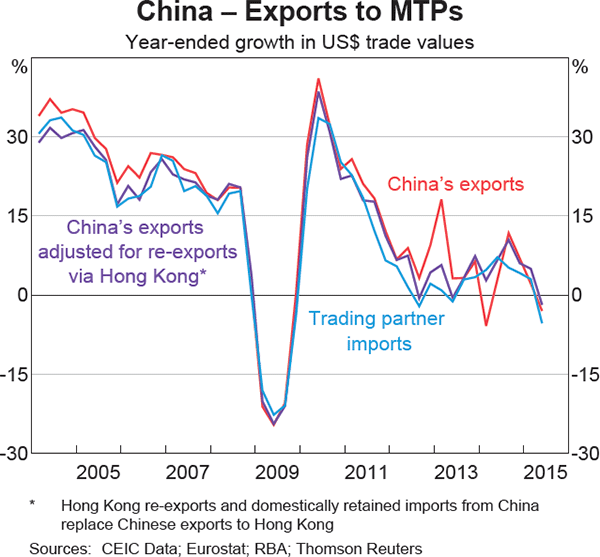
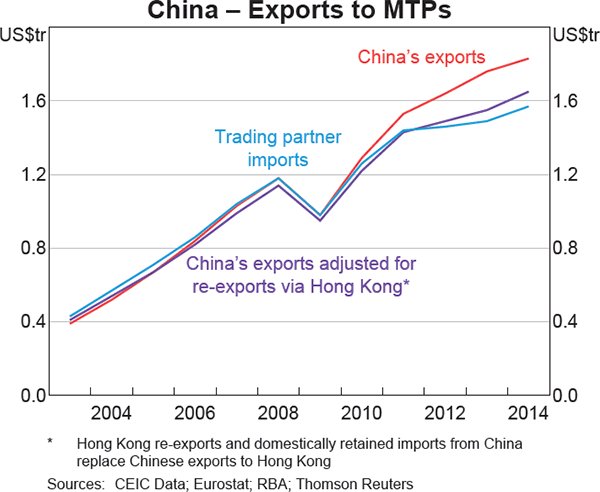
The bulk of this discrepancy can be attributed to the growth in Chinese exports to Hong Kong, as reported in China's trade data. An adjustment to the Chinese export statistics can be made to exclude this discrepancy by replacing these data with the corresponding data reported by Hong Kong – namely, the sum of Hong Kong's domestically retained imports from China and Hong Kong's re-exports from China to other economies as reported in Hong Kong's trade statistics.[9] This adjusted estimate of China's exports to its main trading partners shows a much closer relationship with the trading partner import statistics than the unadjusted series.
The adjustment is likely to be accounting for a range of differences between the Chinese export data and the corresponding mirror statistics that result from the close trading relationship between China and Hong Kong.[10] However, the divergence between the adjusted and unadjusted series – at least in part – is likely to reflect false invoicing of exports from China to Hong Kong in order to circumvent controls on speculative capital inflows. These activities led Chinese authorities to introduce stricter requirements to verify the authenticity of trade documents in 2013.[11] The false invoicing was largely motivated by a positive interest rate differential between investments held in renminbi and in US dollars, and expectations of further appreciation of the renminbi against the US dollar.[12] As foreign exchange earned from exports can be freely converted to renminbi, firms had an incentive to overstate the US dollar value of exports (thereby enabling them to exchange US dollars for renminbi).
The data can be arranged to compare exports from China with imports reported by advanced economies, other east Asia, and other emerging economies. Advanced economies account for a large share of Chinese exports and movements in the Chinese data have aligned closely with the reciprocal data (Graph 3). In particular, trends in Chinese exports to Australia, Japan and the European Union are broadly in line with those in the mirror statistics. Yet the mirror data suggest a higher level of Chinese exports to North American economies than the Chinese data. While the reasons for this are uncertain, there does appear to be substantial transhipment of goods from China to the United States via Hong Kong. There could also be some double counting of imports from China because of re-exporting between close trading partners. This could help to explain the large discrepancy with Canada's import statistics: some Chinese exports to Canada are likely to be re-exported via the United States and would therefore be included in both countries' import statistics (Bohatyretz and Santarossa 2005). Chinese exports to a number of emerging economies (India, Russia and Brazil) also closely track data from those respective countries.
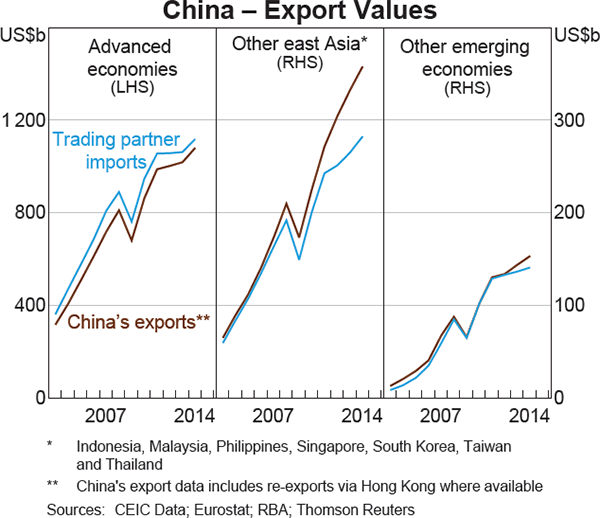
However, as with Hong Kong, there are noticeable divergences between the Chinese data and the mirror statistics published by the other east Asian economies. China's exports to these economies have been higher in the Chinese data than in the corresponding mirror statistics. Relative to each economy's trade with China, the discrepancies have generally been lower for the high-income economies than for the other economies in the region. The absolute size of discrepancies for South Korea, Taiwan and Malaysia has increased substantially since late 2012, showing a similar pattern to Hong Kong (Graph 4).
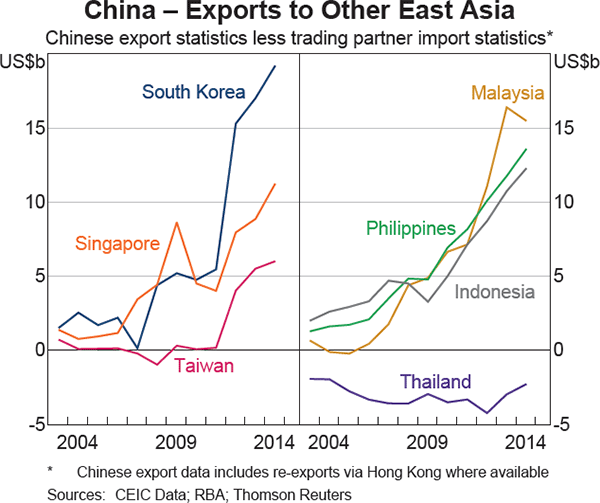
For Singapore, the discrepancy between the reported trade statistics has been relatively large since 2005. Since Singapore is a major international trading hub, this could reflect re-exports or transhipment of goods. As explained above, an export that travels via Singapore may be recorded in the Chinese statistics as an export to Singapore, but since the goods do not clear customs before being shipped to their final destination, they may not be recorded as an import from China by Singapore. Data on re-exports by origin and destination are unavailable for Singapore, unlike Hong Kong, so no adjustment can be made for this.
Imports (from China) reported by Indonesia and the Philippines have also been consistently lower than the corresponding Chinese export statistics. It is possible that this reflects under-reporting by importers in Indonesia and the Philippines in order to avoid import duties. One report has found that the value of imports recorded by the Philippines is typically lower than the mirror statistics reported by many of their trading partners (Wan 2014). By comparison, imports reported by Thailand have been consistently higher than the equivalent Chinese exports. At least in part, this could reflect Hong Kong re-exports from China to Thailand, but data on such activities are unavailable.
China's import data
The trends in China's import statistics line up fairly closely with the trends in exports reported by its MTPs at an aggregate level (Graph 5). Both data sources show a contraction in imports during the global financial crisis, followed by a strong rebound. The weakness in imports since 2014, which partly reflects declines in global commodity prices, is also reflected in both China's data and the mirror statistics.
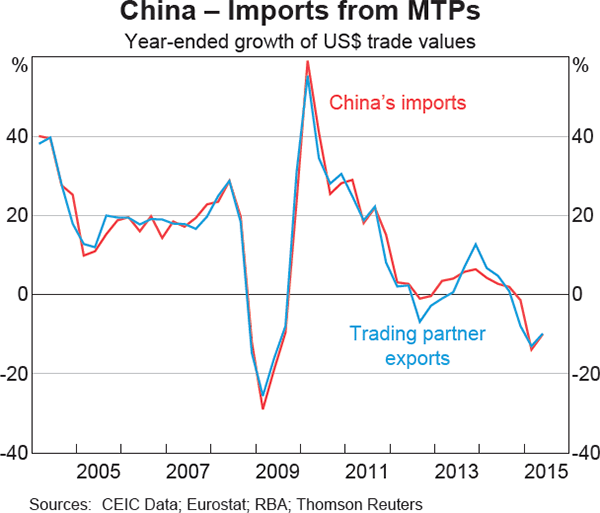
When examined by region, however, there are some discrepancies, particularly for east Asia (Graph 6). The value of imports reported by China has been consistently higher than the corresponding export values reported by other east Asian economies (Graph 7). In part, this could reflect an underestimate of insurance and freight costs, although it seems unlikely that this can explain the large difference under reasonable estimates. Another possible cause of the difference is the transhipment and re-export of goods via major trading hubs (such as Singapore), which have not been adjusted for because the relevant data are not available. China's import statistics will be higher than the corresponding exports if trading partners record transhipment flows as exports to these intermediate destinations rather than China. In particular, a reasonable share of re-exports via Singapore to China is likely to have originated in the other east Asian economies.[13]
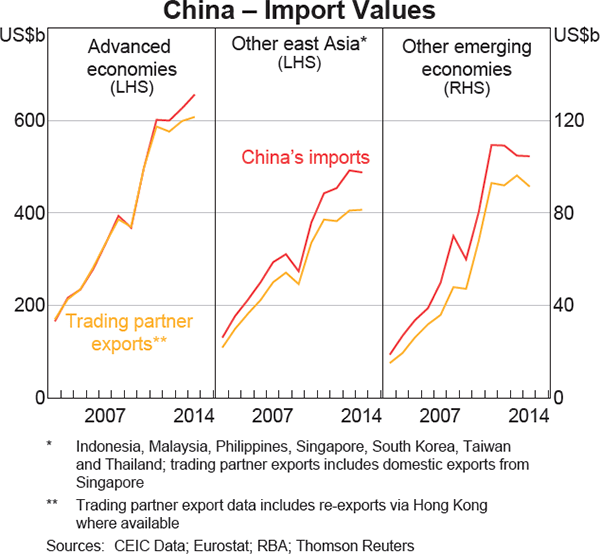
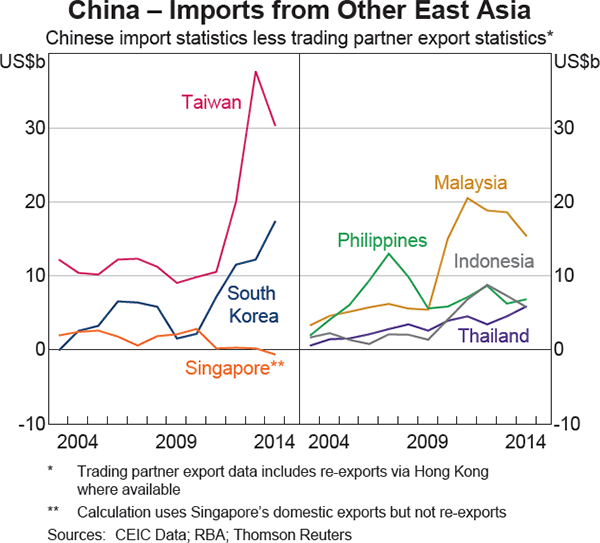
Malaysia's proximity to Singapore could help to explain the large discrepancy in the statistics reported for Chinese imports from Malaysia. Among the other east Asian economies, the statistics for the Philippines have shown the largest differences relative to the total value of bilateral trade. At times, Chinese import values have been more than double the corresponding Philippines export values. However, the difference is relatively small in absolute terms and could reflect issues with the reporting of trade flows in the Philippines. Since late 2012, a divergence has also emerged in the reported statistics for imports from Taiwan and South Korea.
Since early 2014, expectations for a depreciation of the Chinese currency have increased and forecasts for economic growth in China have declined, prompting a rise in private capital outflows from China. This provides an incentive to over-invoice imports to disguise capital flows from China to trading partner economies.
The Chinese import statistics align relatively closely with the mirror statistics for imports from Australia (Graph 8). Chinese demand for iron ore and coal has driven the strong increase in imports from Australia over much of the past decade, with iron ore and coal accounting for around 60 per cent of Australia's exports to China over this period. However, over the past year the value of China's imports from Australia has fallen noticeably, largely reflecting lower commodity prices.

Conclusion
China's merchandise trade data can provide a timely indication of economic conditions in China. There have been doubts about the accuracy of Chinese statistics in recent years, but in many cases China's trade data can be reconciled with reciprocal data reported by its MTPs. Nevertheless, there is evidence that false invoicing of exports to Hong Kong has given rise to significant distortions and increased volatility in Chinese merchandise export data since 2012. As a result, trading partner import data – which have generally suggested growth has been less volatile and somewhat lower over the past three years – may provide a more reliable guide to Chinese exports than the Chinese data, at least for this period. By comparison, the growth rates of merchandise imports reported by China have generally been more consistent with the mirror statistics, although this could change if there continues to be an incentive to disguise capital outflows by over-invoicing imports.
Footnotes
The author is from Economic Group. [*]
For example Wu (2007) and Holz (2014) discuss the accuracy of Chinese gross domestic product (GDP) statistics. [1]
One reason often given for substantial re-exports via Hong Kong is that Hong Kong has an informational advantage in matching buyers and sellers in different markets, and some quality-sorting and marketing services can be undertaken in Hong Kong (Hanson and Feenstra 2001). Similar arguments can be made for other economies that re-export goods, such as Singapore. [2]
Transhipment allows for smaller shipments to be combined or large shipments to be divided, but avoids costs and time delays involved with customs processes. [3]
For example, it takes about two weeks to ship iron ore from Port Hedland in Australia to the northern ports in China. [4]
Chinese and Hong Kong data suggest that there are considerable flows generated from Chinese exports to Hong Kong being re-exported to China (U.S. Department of the Treasury 2007). To the extent that this trade can be identified, it has been excluded from the analysis. [5]
This is the sample average derived by comparing Chinese imports in China's balance of payments statistics, which are compiled on a FOB basis, with Chinese merchandise imports measured on a CIF basis. An estimate by the IMF (1993) suggests a larger proportion (10 per cent), although the authors recognise that these costs can vary. [6]
However, China's exports to Hong Kong exclude the value of any mark-up applied in Hong Kong, which would be included in the corresponding MTP import data. [7]
Total re-exports from Singapore to China are also included in the aggregate MTP data, along with its domestic exports. This assumes that the re-exports from Singapore originated in economies for which we are including the corresponding Chinese import data. This seems reasonable given that the MTPs examined account for around 70 per cent of Singapore's total imports. [8]
Re-exports from China to China via Hong Kong are not included in the adjusted Chinese export series since imports from China have not been included in the corresponding MTP import data. However, it is unclear if re-exports from China to China are included in China's data on exports to Hong Kong. [9]
For a detailed discussion of these, see Liu et al (2008). [10]
For example, see State Administration of Foreign Exchange (2013). [11]
For more information on the role of expectations for the exchange rate in Chinese capital flows, see Hatzvi, Meredith and Nixon (2015). [12]
Although data are not available on the original source of Singapore's re-exports, around one-third of Singapore's total imports are from other east Asian economies. [13]
References
Bohatyretz S and B Santarossa (2005), ‘Merchandise Trade Reconciliation Study: Canada-China, 2002 and 2003’, Canadian Trade Review, Statistics Canada, Cat No 65-507-MWE.
Ferrantino MJ and Z Wang (2008), ‘Accounting for Discrepancies in Bilateral Trade: The Case of China, Hong Kong, and the United States’, China Economic Review, 19(3), pp 502–520.
Hanson GH and RC Feenstra (2001), ‘Intermediaries in Entrepôt Trade: Hong Kong Re-Exports of Chinese Goods’, NBER Working Paper No 8088.
Hatzvi E, J Meredith and W Nixon (2015), ‘Chinese Capital Flows and China's Capital Account Liberalisation’, RBA Bulletin, December, pp 39–48.
Holz CA (2014), ‘The Quality of China's GDP Statistics’, China Economic Review, 30, pp 309–338.
IMF (International Monetary Fund) (1993), A Guide to Direction of Trade Statistics, IMF, Washington DC.
IMF (International Monetary Fund) (2009), Export and Import Price Index Manual: Theory and Practice, IMF, Washington DC.
Liu Y, MM Kemper, P Magrath and CR Giesze (2008), ‘China's Global Trade Balance Discrepancy: Hong Kong Entrepôt Effects and Round-Tripping Chinese Capital’ U.S.China Economic and Security Review Commission Report, 12 September.
State Administration of Foreign Exchange (2013), ‘[State Administration of Foreign Exchange Convenes nspection/Policy Briefing on Bank Trade Finance]’ Press release. Available at <http://www.safe.gov.cn/resources/wcmpages/wps/wcm/connect/safe_web_store/safe_web/whxw/ywfb/node_news_ywfb_store/cfc43f0042348f108409ff3e0e4da78e/>.
U.S. Department of the Treasury (2007), ‘Appendix II: China's Trade Data’, Semiannual Report on International Economic and Exchange Rate Policies, June.
United Nations (2011), International Merchandise Trade Statistics: Concepts and Definitions 2010, Statistical Papers Series M No 52.
Wan M (2014), ‘The Philippines: A False Positive?’, Credit Suisse Economics Research Report, 14 March.
Wu HX (2007), ‘The Chinese GDP Growth Rate Puzzle: How Fast Has the Chinese Economy Grown?’, Asian Economic Papers, 6(1), pp 1–23.